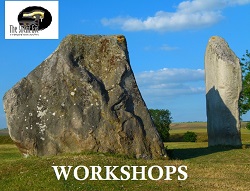
We had driven to Fortingall to see the venerable yew, but it just happens to be in the grounds of a church, so it was inevitable that we would take a look around. We do seem to spend a lot of our holidays in cemeteries from one epoch or another, though the ones we generally favour tend to be as old as the yew itself.

We didn’t even get through the gate without a sense of wonder. We recognised the river-carved stones that topped the gateposts of both the churchyard and almost every gate we passed. They were of the same organic shapes as the family of sacred stones of Tigh na Cailleach, a mysterious shrine not too far away. Too far for us, sadly; we did not have time for a six hour walk through the hills, not this trip anyway, as we were booked for an even longer one the following day, over three hundred miles away.

Even so, it was with wonder that we looked on these stones. The shrine in its hidden glen holds a family of stones, brought out into the light every spring and resealed in their house of stone for the winter. No-one knows how long they have watched over the glen, but they are thought to be ancient, and may have watched for thousands of years. The stones are known as the Cailleach (old woman), the Bodach (old man), the Nighean (daughter) and her siblings, and one legend says the Cailleach gives birth to a new child every hundred years.

Time seems to dance to a different cadence here. The ancient bones of the land are carved by the waters, trees count the passing millennia as naught and ancient sacredness is still respected and revered. Even the sundial, in a place where we were informed there is only six hours of sunshine a year, seems to count time as inconsequential and seeks a deeper meaning.

Inside the gate the old eighteenth century belfry has been preserved. Rather confident-looking angels watch from tombstones and as you wander, you cannot help wondering about the lives of the people whose presence they remember.

There are tombstones both ancient and modern, many of which bear symbols that tell their own stories but which, not knowing those stories we cannot hear. They are familiar tales, all of them, yet we lack the keys to unravel them from the scant clues on the stones.

We may read the names, dates and honours of each individual or family, we may know who they married, how many children they had and occasionally, what they did for a living… but their real stories are silent. We do not know how they laughed, or how many tears they shed. We cannot know how they loved, or if they loved, or what brought them joy.

For the more modern burials, there may still be family stories in the minds and hearts of the living. The great families have their records, biographies and their place in history, but these are only facts. Once the last person who remembers them is gone, even the most prolific diarist, artist or writer leaves only a reflection for the world to ponder. The warmth and depth of human presence flies with the departing soul.

The churchyard at Fortingall holds memorial stones from its fourteen hundred years of Christian presence. From the elaborate to the humble, from rich marble to worn and re-used stone, the life of the village and its people is brought at the end to a single place of peace.

I wondered what legacy each had left to the world. Doctors and masons, soldiers and farmers, how had they changed it by their presence… because we all do. Some worry about posterity and how they will be remembered… if they will be remembered. Perhaps that is an offshoot of the ego’s fear of annihilation. Biblical verses, poetry and quotations are carved by those who remain, either as a blessing or in a vain attempt to capture the achievements or the essence of the person who lies beneath the stone.

It should be enough that we have lived and been part of the human story… no matter how small a part we believe we play on the vast screen of history. Without our presence, that story would not, could not be the same. I got to wondering, as I read the epitaphs of the people of Fortingall, what I would like someone to carve on my tombstone, in the unlikely event that I will have one. With what phrase or epithet would I hope they might sum up my life?

Would I really want them to list worldly achievements or praise me for virtues I might only be endowed with in retrospect? I sought for something else, some phrase that had many meanings and told as many stories as a lifetime can hold. It all came down to two words. ‘She loved.’




How beautiful as always, Sue. For most of us, our worldly possession and achievements won’t be remembered, but having loved, we leave a lasting imprint in the generations to come.
LikeLike
I don’t think we can hope for better than that.
LikeLiked by 1 person
A fine and accurate summation, Sue. That, you have, and thousands have benefited from that love. ❤
LikeLike
❤
LikeLike
The best way to be remembered. (K )
LikeLike
I think so 🙂
LikeLiked by 1 person